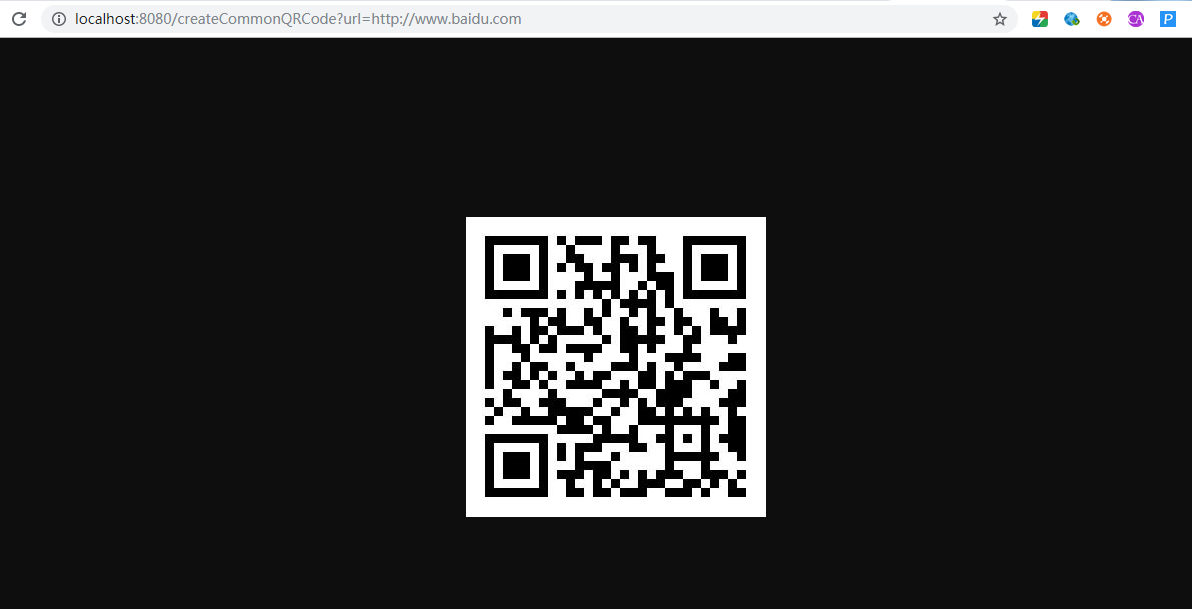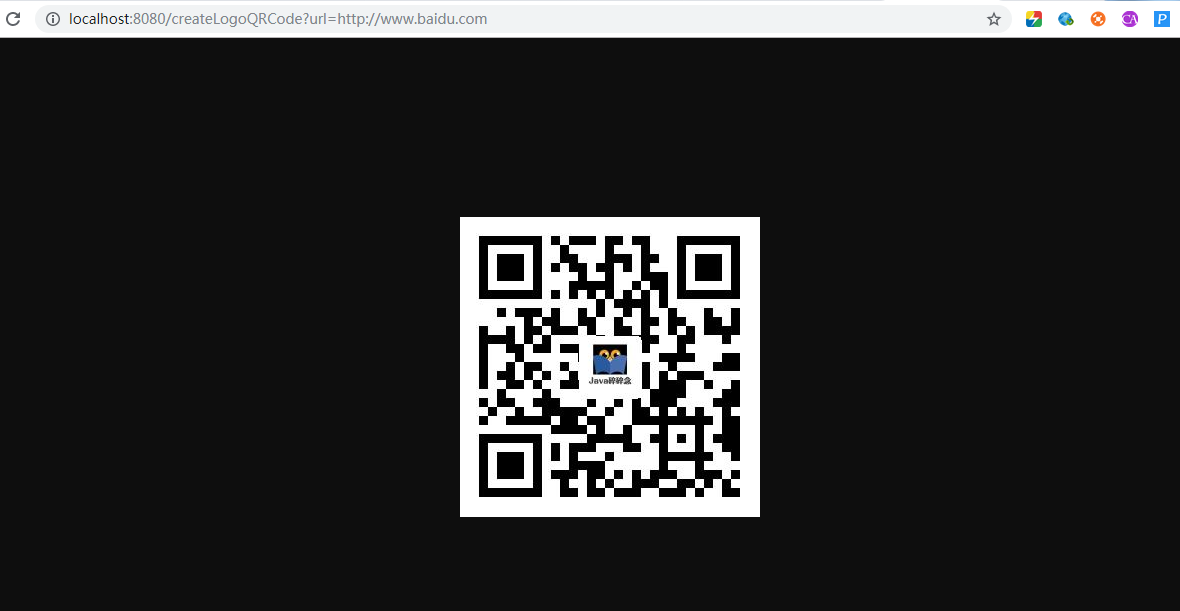利用Spring Boot+zxing,生成二維碼還能這麼簡單
- 2019 年 10 月 3 日
- 筆記
在網站開發中,經常會遇到要生成二維碼的情況,比如要使用微信支付、網頁登錄等,本文分享一個Spring Boot生成二維碼的例子,這裡用到了google的zxing工具類。
本文目錄
一、二維碼簡介二、編寫程式碼生成二維碼1.引入jar包2.編寫工具類3.編寫控制層程式碼4.運行並查看效果
一、二維碼簡介
二維碼又稱為QR Code,QR全稱是Quick Response,是一個近幾年來移動設備上超流行的一種編碼方式。
二維碼是用某種特定的幾何圖形按一定規律在平面(二維方向上)分布的黑白相間的圖形記錄數據符號資訊的。
主要應用場景如下:
- 資訊獲取(名片、地圖、WIFI密碼、資料)
- 網站跳轉(跳轉到微博、手機網站、網站)
- 廣告推送(用戶掃碼,直接瀏覽商家推送的影片、音頻廣告)
- 手機電商(用戶掃碼、手機直接購物下單)
- 防偽溯源(用戶掃碼、即可查看生產地;同時後台可以獲取最終消費地)
- 優惠促銷(用戶掃碼,下載電子優惠券,抽獎)
- 會員管理(用戶手機上獲取電子會員資訊、VIP服務)
- 手機支付(掃描商品二維碼,通過銀行或第三方支付提供的手機端通道完成支付)
- 帳號登錄(掃描二維碼進行各個網站或軟體的登錄)
二、編寫程式碼生成二維碼
1.引入jar包
pom.xml中引入zxing的jar包。
<!-- 二維碼支援包 -->
<dependency>
<groupId>com.google.zxing</groupId>
<artifactId>core</artifactId>
<version>3.2.0</version>
</dependency>
<dependency>
<groupId>com.google.zxing</groupId>
<artifactId>javase</artifactId>
<version>3.2.0</version>
</dependency>
2.編寫工具類
QRCodeUtil.java程式碼如下:
/**
* QRCodeUtil 生成二維碼工具類
*/
public class QRCodeUtil {
private static final String CHARSET = "utf-8";
private static final String FORMAT_NAME = "JPG";
// 二維碼尺寸
private static final int QRCODE_SIZE = 300;
// LOGO寬度
private static final int WIDTH = 60;
// LOGO高度
private static final int HEIGHT = 60;
private static BufferedImage createImage(String content, String imgPath, boolean needCompress) throws Exception {
Hashtable hints = new Hashtable();
hints.put(EncodeHintType.ERROR_CORRECTION, ErrorCorrectionLevel.H);
hints.put(EncodeHintType.CHARACTER_SET, CHARSET);
hints.put(EncodeHintType.MARGIN, 1);
BitMatrix bitMatrix = new MultiFormatWriter().encode(content, BarcodeFormat.QR_CODE, QRCODE_SIZE, QRCODE_SIZE,
hints);
int width = bitMatrix.getWidth();
int height = bitMatrix.getHeight();
BufferedImage image = new BufferedImage(width, height, BufferedImage.TYPE_INT_RGB);
for (int x = 0; x < width; x++) {
for (int y = 0; y < height; y++) {
image.setRGB(x, y, bitMatrix.get(x, y) ? 0xFF000000 : 0xFFFFFFFF);
}
}
if (imgPath == null || "".equals(imgPath)) {
return image;
}
// 插入圖片
QRCodeUtil.insertImage(image, imgPath, needCompress);
return image;
}
private static void insertImage(BufferedImage source, String imgPath, boolean needCompress) throws Exception {
File file = new File(imgPath);
if (!file.exists()) {
System.err.println("" + imgPath + " 該文件不存在!");
return;
}
Image src = ImageIO.read(new File(imgPath));
int width = src.getWidth(null);
int height = src.getHeight(null);
if (needCompress) { // 壓縮LOGO
if (width > WIDTH) {
width = WIDTH;
}
if (height > HEIGHT) {
height = HEIGHT;
}
Image image = src.getScaledInstance(width, height, Image.SCALE_SMOOTH);
BufferedImage tag = new BufferedImage(width, height, BufferedImage.TYPE_INT_RGB);
Graphics g = tag.getGraphics();
g.drawImage(image, 0, 0, null); // 繪製縮小後的圖
g.dispose();
src = image;
}
// 插入LOGO
Graphics2D graph = source.createGraphics();
int x = (QRCODE_SIZE - width) / 2;
int y = (QRCODE_SIZE - height) / 2;
graph.drawImage(src, x, y, width, height, null);
Shape shape = new RoundRectangle2D.Float(x, y, width, width, 6, 6);
graph.setStroke(new BasicStroke(3f));
graph.draw(shape);
graph.dispose();
}
public static void encode(String content, String imgPath, String destPath, boolean needCompress) throws Exception {
BufferedImage image = QRCodeUtil.createImage(content, imgPath, needCompress);
mkdirs(destPath);
ImageIO.write(image, FORMAT_NAME, new File(destPath));
}
public static BufferedImage encode(String content, String imgPath, boolean needCompress) throws Exception {
BufferedImage image = QRCodeUtil.createImage(content, imgPath, needCompress);
return image;
}
public static void mkdirs(String destPath) {
File file = new File(destPath);
// 當文件夾不存在時,mkdirs會自動創建多層目錄,區別於mkdir.(mkdir如果父目錄不存在則會拋出異常)
if (!file.exists() && !file.isDirectory()) {
file.mkdirs();
}
}
public static void encode(String content, String imgPath, OutputStream output, boolean needCompress)
throws Exception {
BufferedImage image = QRCodeUtil.createImage(content, imgPath, needCompress);
ImageIO.write(image, FORMAT_NAME, output);
}
public static void encode(String content, OutputStream output) throws Exception {
QRCodeUtil.encode(content, null, output, false);
}
}
3.編寫控制層程式碼
QrCodeController.java程式碼如下:
/**
* 根據 url 生成 普通二維碼
*/
@RequestMapping(value = "/createCommonQRCode")
public void createCommonQRCode(HttpServletResponse response, String url) throws Exception {
ServletOutputStream stream = null;
try {
stream = response.getOutputStream();
//使用工具類生成二維碼
QRCodeUtil.encode(url, stream);
} catch (Exception e) {
e.getStackTrace();
} finally {
if (stream != null) {
stream.flush();
stream.close();
}
}
}
/**
* 根據 url 生成 帶有logo二維碼
*/
@RequestMapping(value = "/createLogoQRCode")
public void createLogoQRCode(HttpServletResponse response, String url) throws Exception {
ServletOutputStream stream = null;
try {
stream = response.getOutputStream();
String logoPath = Thread.currentThread().getContextClassLoader().getResource("").getPath()
+ "templates" + File.separator + "logo.jpg";
//使用工具類生成二維碼
QRCodeUtil.encode(url, logoPath, stream, true);
} catch (Exception e) {
e.getStackTrace();
} finally {
if (stream != null) {
stream.flush();
stream.close();
}
}
}
4.運行並查看效果
本項目中提供了生成普通二維碼和帶有logo二維碼的兩個介面,啟動項目,我們來演示下生成下http://www.baidu.com這個url的二維碼;
- 生成普通二維碼
本地瀏覽器打開http://localhost:8080/createCommonQRCode?url=http://www.baidu.com,生成的二維碼截圖如下:

生成百度的普通二維碼
- 生成帶logo的二維碼
本地瀏覽器打開http://localhost:8080/createLogoQRCode?url=http://www.baidu.com,生成的二維碼截圖如下:

生成百度的帶logo二維碼
到此Spring Boot 2.X中利用ZXing生成二維碼功能全部實現,有問題歡迎留言溝通哦!
完整源碼地址: https://github.com/suisui2019/springboot-study
推薦閱讀
1.從技術的角度分析下為什麼不要在網上發“原圖”
2.Spring Boot 2.X 如何快速整合jpa?
3.Spring Boot之Profile–快速搞定多環境使用與切換
4.Spring Boot 2.X整合Spring-cache,讓你的網站速度飛起來
5.利用Spring Boot+WxJava實現網站集成微信登錄功能
限時領取免費Java相關資料,涵蓋了Java、Redis、MongoDB、MySQL、Zookeeper、Spring Cloud、Dubbo/Kafka、Hadoop、Hbase、Flink等高並發分散式、大數據、機器學習等技術。
關注下方公眾號即可免費領取:

